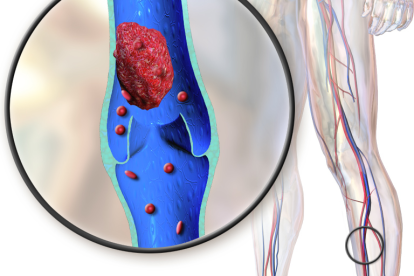Deep vein thrombosis: a serious threat to athletes
Milwaukee Bucks player Damian Lillard is the latest professional athlete to suffer from this career-threatening condition.

Wembanyama and Lillard
The Milwaukee Bucks have received some of the worst news they could get at this point in the regular season. Damian Lillard, one of the franchise's stars, will not return to the court and will be out indefinitely after suffering a career-threatening condition in professional athletes: a deep vein thrombosis, commonly known as DVT.
Lillard, whose injury is located in his right calf, is the latest in the long list of athletes who in recent decades have had to take time to recover from a DVT.
Many questions about this condition remain unanswered, such as where it typically occurs in the body, what its symptoms are, and how long recovery takes.
What is a DVT and how is it treated?
According to the National Heart, Lung, and Blood Institute (NHLBI), an agency within the National Institutes of Health (NIH), DVT is "the most common type of venous thromboembolism (VTE)." Specifically, it is a condition that occurs "when a blood clot forms in a deep vein."
DVT most commonly occurs in the thighs, the pelvis or the calves, as seen in Lillard's case. According to the NHLBI, common symptoms include swelling, pain, tenderness in the affected area, muscle cramps discomfort and skin redness.
The biggest risk of DVT is that a blood clot can travel through the bloodstream to vital organs like the lungs, potentially causing a pulmonary embolism (PE) or even death.
DVT has a genetic component, meaning a family history can increase the risk of developing it. However, it can also be triggered by prolonged inactivity, which leads to faster blood clotting and vein obstruction. Certain conditions, such as cancer and obesity, also contribute to its development. Pregnancy is another risk factor.
How is it treated and how long does it take to recover?
There are three main treatments for DVT. The most common is medication, where doctors prescribe anticoagulants—either as injections or pills—to help dissolve the clot.

DVT
The second treatment option is thrombolysis, which involves inserting a catheter into the affected vein. Once the clot is reached, a drug is released to dissolve it. This procedure requires local anesthesia.
Lastly, surgery is an option, though it is rare and reserved for severe cases. It is considered when a patient does not respond to anticoagulants, leaving no other choice but to surgically remove the clot.
Recovery time varies for each case, but sick leave can sometimes extend beyond a year.
History in sports
Lillard is not the only elite athlete to experience DVT while active. Both current and former NBA players have also faced time on the sidelines due to the condition.
Before the Bucks player, the most recent case was that of Victor Wembanyama. The young Frenchman from the San Antonio Spurs was diagnosed in February, though his DVT appeared in the right shoulder, which is a less common location.
One of the most distressing cases in recent memory was that of Miami Heat center Chris Bosh. At 32, his career was cut short in 2016 after multiple blood clots were found in his lungs. Despite seeking several medical opinions, he was ultimately forced to retire for safety reasons.
Last year, Detroit Pistons shooting guard Ausar Thompson was diagnosed with blood clots in March during his rookie season, causing him to miss 18 games. This was one fewer than Brandon Ingram, who had to sit out for a DVT in 2019. Other NBA players with similar experiences include Anderson Varejao, Mirza Teletovic, and Christian Koloko.
Outside of the NBA, NHL players Kimmo Timonen, Jed Ortmeyer, Tomas Fleischmann, Pascal Dupuis, and Tomas Vokoun, along with handball player Nikola Karabatic, have also suffered from blood clots.
"Another highly notable case was that of Serena Williams, one of the greatest tennis players in history. She was diagnosed with blood clots, including a pulmonary embolism in 2011 at the age of 29, which sidelined her for nearly a year. Although she made a comeback, the pulmonary embolism resurfaced after giving birth in 2017. Thankfully, she was eventually able to recover.
RECOMMENDATION























